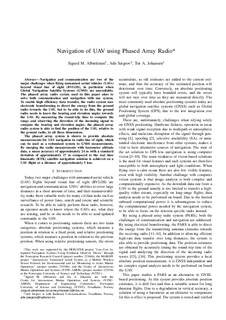| dc.contributor.author | Albrektsen, Sigurd Mørkved | |
| dc.contributor.author | Sægrov, Atle | |
| dc.contributor.author | Johansen, Tor Arne | |
| dc.date.accessioned | 2017-12-12T13:47:44Z | |
| dc.date.available | 2017-12-12T13:47:44Z | |
| dc.date.created | 2017-12-10T11:56:49Z | |
| dc.date.issued | 2017 | |
| dc.identifier.isbn | 978-1-5386-0938-5 | |
| dc.identifier.uri | http://hdl.handle.net/11250/2470843 | |
| dc.description.abstract | Navigation and communication are two of the major challenges when flying unmanned aerial vehicles (UAVs) beyond visual line of sight (BVLOS), in particular when Global Navigation Satellite Systems (GNSS) are unavailable. The phased array radio system used in this paper aims to solve both communication and navigation with one system. To enable high efficiency data transfer, the radio system uses electronic beamforming to direct the energy from the ground radio towards the UAV, but to be able to do this, the ground radio needs to know the bearing and elevation angles towards the UAV. By measuring the round-trip time to compute the range and observing the direction of the incoming signal to compute the bearing and elevation angles, the phased array radio system is able to find the position of the UAV, relative to the ground radio, in all three dimensions. The phased array system is shown to provide absolute measurements for UAV navigation in radio line of sight, which can be used as a redundant system to GNSS measurements. By merging the radio measurements with barometer altitude data, a mean accuracy of approximately 24 m with a standard deviation of approximately 17 m compared to the real time kinematic (RTK) satellite navigation solution is achieved on a UAV flight at a distance of approximately 5 km. | nb_NO |
| dc.language.iso | eng | nb_NO |
| dc.publisher | Institute of Electrical and Electronics Engineers (IEEE) | nb_NO |
| dc.relation.ispartof | 2017 Workshop on Research, Education and Development of Unmanned Aerial Systems (RED-UAS) | |
| dc.title | Navigation of UAV using Phased Array Radio | nb_NO |
| dc.type | Chapter | nb_NO |
| dc.type | Peer reviewed | nb_NO |
| dc.description.version | acceptedVersion | nb_NO |
| dc.identifier.doi | 10.1109/RED-UAS.2017.8101657 | |
| dc.identifier.cristin | 1525262 | |
| dc.relation.project | Norges forskningsråd: 223254 | nb_NO |
| dc.relation.project | Norges forskningsråd: 269480 | nb_NO |
| dc.relation.project | Norges forskningsråd: 221666 | nb_NO |
| dc.description.localcode | © 2017 IEEE. Personal use of this material is permitted. Permission from IEEE must be obtained for all other uses, in any current or future media, including reprinting/republishing this material for advertising or promotional purposes, creating new collective works, for resale or redistribution to servers or lists, or reuse of any copyrighted component of this work in other works. | nb_NO |
| cristin.unitcode | 194,63,25,0 | |
| cristin.unitcode | 194,63,35,0 | |
| cristin.unitname | Institutt for teknisk kybernetikk | |
| cristin.unitname | Institutt for elektroniske systemer | |
| cristin.ispublished | true | |
| cristin.fulltext | postprint | |
| cristin.qualitycode | 1 | |
